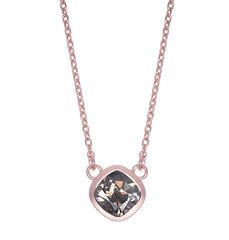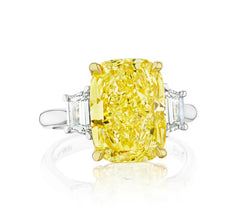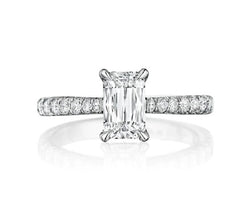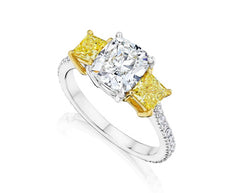Diamonds evoke a feeling of enchantment—clean and white, with dazzling brilliance. What may not be immediately apparent is that very few diamonds are truly white, or what gemologists call colorless. Most diamonds have been affected by other elements during their long period of formation deep within the earth and often emerge with the palest of yellow or brown tints.
Rarely will a diamond emerge as truly colorless, but when such a diamond appears, it is valued much more highly than similarly sized diamonds with more tint. Even more valuable, however, are the exceedingly rare diamonds that emerge with surprising, vibrant colors. When it comes to diamond color, there’s a full spectrum of beauty to behold.
What is Diamond Color?
Diamonds are graded on color, though perhaps the most accurate way to describe this grading is as lack of color. Most diamonds in the jewelry market are colorless or near colorless to achieve jewelry settings with the ubiquitous white diamond sparkle and fire.
The 4Cs of Diamonds
Diamond color is one of the 4Cs used to grade diamonds. Gemologists use color and three other qualities, all beginning with the letter C, to provide a standardized assessment of diamonds. No quality is more or less important than another, but together, the 4Cs paint a helpful, quantitative picture of the diamond to help the consumer prioritize their preferred qualities. The 4Cs of diamond grading are:
- Color
- Cut
- Clarity
- Carat
What Color Are Diamonds?
Most diamonds fall within what is referred to as the normal color range. This range begins with white or colorless and extends to pale yellow or brown. The diamonds most people are familiar with are colorless or nearly colorless and are what buyers encounter in a jewelry case.
How Do Diamonds Get Their Color?
Diamonds form deep within the earth when carbon atoms are subjected to high pressure over long periods of time. The interior of the earth is composed of more than just carbon atoms, however, and these other minerals can interfere with the diamond’s formation.
Sometimes, these minerals result in inclusions that affect the diamond’s clarity, another of the 4Cs. These minerals can also affect the diamond’s crystal structure, affecting color.
What is the Diamond Color Scale?
The Gemological Institute of America (GIA) grades diamond color using an alphabetical scale from D to Z to describe the tint of white diamonds. To make an accurate assessment, gemologists view a diamond upside down and from the side to get a neutral view of the stone, avoiding the face-up sparkle and fire that result from the cut facets. The trained gemologist then compares the diamond’s color to a set of master stones to ensure consistent grading.
The highest color grade available is D, reserved for truly colorless diamonds. The lowest color grade for white diamonds is Z, reserved for diamonds that appear light yellow, brown, or gray. Gemologist group these 23 grades into sets:
- Colorless: D-F
- Near Colorless: G-J
- Faint: K-M
- Very Light: N-R
- Light: S-Z
Why Was the Diamond Color Scale Established?
The GIA established the D-to-Z color scale in 1953, providing a universal grading system to describe the depth of color across diamonds. This scale has been adopted internationally and is used for white diamonds to give consistent grades for diamond color.
Diamond Colorless and Near Colorless Grading
Diamonds with less color are typically considered more desirable. Just as flawless diamonds are considered perfection in terms of clarity, truly colorless diamonds in grades D, E, or F are rare and considerably more expensive than diamonds with more tint.
Most jewelry uses diamonds in the D-to-M color range, but at Fink’s Jewelers, we offer stones only in our Superior Quality® color range D-to-K to ensure only the best diamonds to celebrate your biggest moments.
Very Light and Light Colored Diamonds
Diamonds with excessive tinting are graded toward the bottom of the color scale in either the Very Light or Light grading set. These stones are too tinted to be desirable as white diamonds, yet not vibrant enough to be classified as fancy diamonds. These diamonds are often used for industrial applications instead of in jewelry.
What Are Fancy Colored Diamonds?
Stunning, rare, and highly coveted, fancy colored diamonds are almost magical and continue to garner attention. These diamonds were subjected to special conditions while forming and include more color than is addressed in the white diamond D-Z color scale.
Diamonds are described as fancy colored if they contain more color saturation than a white diamond grade Z. A diamond also qualifies as a fancy color diamond if it is any saturation in a color other than brown, yellow, or gray.
These coveted stones are assessed using a separate scale and are compared against only diamonds in their own color families. In these special stones, depth and intensity of color are highly valued. The more vibrant the color, the more desirable the stone.
Are Fancy Colored Diamonds Rare?
Only 1 in 10,000 cut diamonds meet the color requirements to be considered fancy colored diamonds. Fancy colored diamonds with intense color are even rarer and are only 1 in 25,000 cut diamonds. Red, green, purple, and orange are the rarest fancy color diamonds.
How Do Fancy Colored Diamonds Get Their Color
The unique hues of colored pearls are imparted by various environmental factors, and we see similar effects with diamonds. These rare colored gems form naturally in a variety of different shades depending on the elements, heat, and pressure that occurred during the diamond’s formation. Fancy colored diamonds include a wide variety of hues, including:
- Yellow
- Blue
- Pink
- Red
- Black
- Orange
- Purple
- Brown
- Green
Natural Colored Diamonds vs Treated Colored Diamonds
While natural fancy colored diamonds are exceedingly rare and occur only under very specific, exacting circumstances, technological advancements have made it possible to manufacture or artificially treat diamonds to achieve a look very similar to the naturally occurring fancy diamond.
While natural diamonds are known to hold their value well and may even increase in value over time, buyers should be cautious of laboratory-grown or treated diamonds. Manufactured diamonds typically maintain very little resale value.
Blue Fancy Diamonds
A naturally occurring blue diamond forms much deeper within the earth than standard diamonds – four times deeper, in fact. The presence of boron gives these diamonds their captivating blue hue. The famed Hope diamond is an example of a fancy blue diamond.
Diamond producers can also create blue diamonds by treating earth-mined diamonds with a high-pressure, high-temperature process (HPHT) and introducing boron, which imparts the blue color.
Yellow Fancy Diamonds
The most common element that interferes with diamond formation is nitrogen, which absorbs blue light within the gem and makes the reflected light appear a shade of yellow.
Fancy yellow diamonds have significantly more nitrogen than their white diamond cousins, resulting in stunning yellow gems, also known as canary diamonds. Yellow diamonds are among the more accessible fancy diamonds.
Laboratory-grown diamonds mimic the natural process of creating yellow diamonds with the addition of nitrogen. As the lab creates the diamond via either the HPHT process or chemical vapor deposition (CVD), the manufacturer simply adds nitrogen to the carbon to tint the stone its signature yellow hue.
Red and Pink Fancy Diamonds
Red and pink diamonds are among the rarest, and thus most expensive, of the fancy diamond colors. Red and pink diamonds are formed under high pressure and intense heat. These stressors don’t introduce contaminants that alter color but rather change the molecular structure of the diamond.
This process is called plastic deformation and is so intense that most pink diamonds don’t survive it. Those that do survive are typically small.
The most common way to replicate these precious red and pink diamonds in a lab is through radiation. A diamond is lab-grown with nitrogen impurities and then subjected to radiation and heat.
Fancy Diamond Color Grading
GIA began producing reports for colored diamonds in 1956. They established a grading scale from Faint to Fancy Vivid to describe the intensity of color present in fancy diamonds. This grading scale exists outside of the color grading scale for white diamonds, graded D-to-Z.
Fancy diamonds should exhibit color more vibrant than the Z grade, though colored diamonds are only compared to master stone diamonds of the same color. The fancy colored diamond grades are:
- Faint
- Very Light
- Light
- Fancy Light
- Fancy
- Fancy Dark
- Fancy Intense
- Fancy Deep
- Fancy Vivid
Considering Color when Choosing Your Diamond
When choosing a diamond, there are a number of factors at play, including color. The 4Cs work together, and each element can play off the others to highlight the diamond features that you find most important. Other jewelry elements can also impact the way that diamond color is highlighted or minimized in your overall jewelry design.
Shape’s Impact on Diamond Color
If shape is more important to you than color, you can choose a diamond with a lesser color grade and disguise it with a round brilliant cut. This many-faceted shape hides color well and boasts intense fire and brilliance, which distract from any yellow tint. A step-cut diamond with open facets like the emerald cut, princess cut, and Asscher cut, however, shows more color.
Cut's Impact on Diamond Color
A well-cut diamond maximizes fire and brilliance, which can mask any unwanted tint in a stone. The cut of a diamond is not the same as a diamond’s shape. Cut refers to the proportions and symmetry of a diamond, which affect the overall sparkle of the stone. A poorly cut will not reflect light well, allowing more of the diamond’s color to be visible.
Clarity's Impact on Diamond Color
Highly included stones will reflect light more poorly, which makes color more visible in a white diamond. We suggest prioritizing diamond clarity first by finding an eye-clean stone, then moving on to color, which can also be affected by setting.
Setting’s Impact on Diamond Color
The setting of a diamond refers to the metal used to secure the stone to a band or other jewelry base. The setting can be fashioned in a number of different ways, but the most common setting is the basic prong style.
The color of the metal prongs touching the diamond’s edge can raise or lower the perceived color of the diamond by about one grade. Yellow gold and rose gold impart a warmer tone, while platinum and white gold can give your diamond a whiter appearance.
Carat's Impact on Diamond Color
Color becomes more important as the diamond carat gets larger. Generally, pay more attention to color once you select a diamond of 1.0 carat or larger. The color of small accent stones, especially those in pavé settings, is usually negligible.
Can You Use a Fancy Diamond for an Engagement Ring?
While white diamonds are a beautiful and traditional choice for engagement rings, couples who wish to make a statement should consider a fancy diamond for a truly unique engagement ring. Our collection of colored gemstone wedding bands is also a way to inject color into your wedding set if you prefer to keep a traditional white diamond engagement ring.
Should You Match Your Center Diamond with Your Side Stones?
Many ring designs feature three or more stones. While three fancy diamonds would make a stunning ring, you aren’t obligated to a monochromatic design. Flanking a fancy diamond with smaller white diamonds helps its brilliant color truly shine in a three-stone design.
5 of Our Top Fancy Color Diamond Choices
At Fink’s Jewelers, we pride ourselves on offering only the best diamonds in our signature Superior QualityÒ. Showcase the rare beauty of a fancy colored diamond in a jewelry piece that you’re sure to love for a lifetime.
- Fink’s Exclusive yellow diamond engagement ring
- Sabel Collection yellow gold fancy diamond ring
- Sabel Collection rose gold fancy diamond pendant
- Sabel Collection white gold fancy halo ring
- Sabel Collection fancy diamond domed ring
Trust Fink’s to guide you to a diamond of the highest quality, whether colorless or vibrant. Traditional white diamonds are always elegant and refined, while fancy colored diamonds are true head-turners. When it comes to diamonds, you’ll find beauty in every hue.














